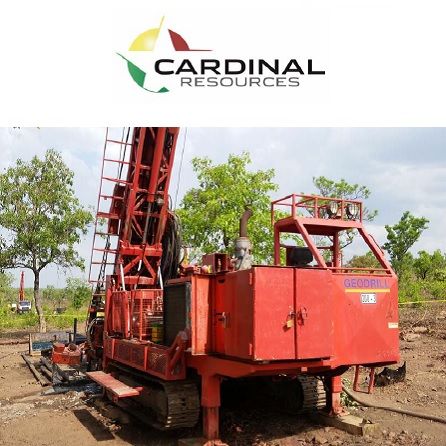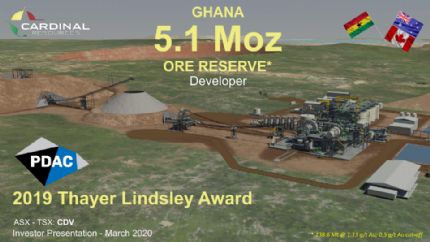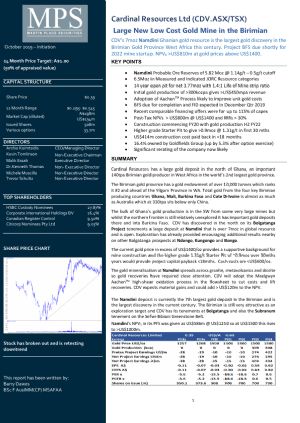
Wide Gold Zone Continues with Infill Drilling at Namdini
Perth, May 25, 2016 AEST (ABN Newswire) - Cardinal Resources Limited ( ASX:CDV) announces the results of a further two diamond drill holes, NMDD356-717 and NMDD354-737, recently completed on the Namdini Project ("Namdini") (Figure 1, see link below).
ASX:CDV) announces the results of a further two diamond drill holes, NMDD356-717 and NMDD354-737, recently completed on the Namdini Project ("Namdini") (Figure 1, see link below).
Highlights:
- Wide gold mineralised zone of 220m with infill diamond drilling
- Mineralised section extends gold zone by 50m further south along strike at depth
- Significant gold mineralised intersection within this section include:
-- 55m @ 1.62 g/t
The gold potential of the Namdini Project continues to be confirmed by the intersection of a mineralised zone of 55m @ 1.62 g/t within diamond drill hole NMDD354-737.
Infill diamond drill holes NMDD356-717 and NMDD354-737 have enabled Section B to be compiled with a 220m wide gold mineralised zone (Figure 1, see link below). This mineralised section is the southernmost diamond drill section drilled to date within the Namdini Project and confirms the continuation of gold mineralisation at depth further south along strike.
The volcaniclastics intersected in both diamond drill holes are mineralised throughout which confirm that gold mineralisation is consistently being intersected along strike and at depth.
Infill diamond drilling is being done at 50m spacings between previous 100m spaced diamond drill sections to confirm and enhance the gold mineralisation previously intersected within the volcaniclastics, granitoids and diorites (Figure 1).
Currently the Cardinal drill rig and two contract drill rigs are on site drilling holes NMDD432-740, NMDD452-748 and NMRD407-710. Samples from 9 drill holes are at the laboratory, which should shortly provide a constant flow of results (Figure 1).
NMDD356-717 intersected 187m of gold mineralisation within hydrothermally altered volcaniclastics from 73m to 260m vertical depths with multiple zones of mineralisation down the drill hole, confirming continuity of mineralisation at depth and along strike to the south (Figures 2 and 3, see link below).
NMDD354-737 intersected 155m of mineralisation within hydrothermally altered volcaniclastics from 25m to 180m vertical depths, including 55m @ 1.72 g/t from 69m vertical depth (Figures 2 and 4, see link below).
Drill holes NMDD356-717 and NMDD354-737 were cored from surface. The soft near surface materials were drilled with a Triple Tube core barrel to reduce core losses. Once harder rock was encountered, then HW steel casing was inserted for stability of each hole and HQ size core was drilled to their final depths of 393.43m and 297.60m respectively.
The drill rigs were aligned for both drill holes at -65DEG dip drilling east which allows for the shallowing of the drill holes with depth. The azimuth was set at 095DEG instead of 100DEG (normal to the strike of the formations) as the borehole traces usually deflects to the right with depth due to the clockwise rotation of the drill rods.
The drill holes were surveyed near the top of each drill hole, then every 30m down the hole to determine the dip and azimuth of the drill holes with depth.
The core was orientated at each drill run using a digital instrument. The core was marked showing the base of the drill hole, then the core from each drill run was laid in a length of angle iron to fit the core together so that the orientation line could be drawn along the length of the core at the drill site. Geotechnical parameters were measured using this orientation line as the datum line.
The core was photographed then cut in half and then cut in half again. One quarter of the core was consistently sampled, with the remaining three quarters stored in metal core trays and placed on metal racks under cover in the core shed at Bolgatanga. The quarter core samples were sent to the SGS Laboratory in Burkina Faso for sample preparation and fire assay.
Planned Diamond Drilling Program
Further infill diamond drill holes along sections at 50m spacings between previous 100m spaced diamond drill sections are planned to evaluate the NNE trending gold mineralised corridor (marked in black circles on Figure 1). All of these drill holes are planned to drill across this mineralised corridor to confirm the continuation of gold mineralisation along strike and at depth.
Namdini Geology
The Namdini Project is located within a Paleo-Proterozoic Greenstone Belt comprising Birimian metavolcanics, volcaniclastics and metasediments located in close proximity to a major 30 km ~N-S regional shear zone with splays. These rock units are intruded by felsic monzonite granitoids and quartz diorites.
The gold mineralisation is developed within foliated, sheared and highly altered volcaniclastic rocks containing sulphides (pyrite and arsenopyrite). The host rocks dip approximately 60DEG W and strike 010DEG. Hydrothermal alteration of the volcaniclastics is comprised of silica, iron carbonate (ankerite), sericite, epidote and chlorite. The highly altered rocks contain disseminated gold-bearing sulphides and are distinguished from the grey, unaltered, unmineralised host rocks by characteristic pale to medium green colours.
The monzonite granitoids are medium to coarse grained with quartz vein stockworks and are usually altered to pale green epidote with patches of pink to reddish albite (alkali feldspar). Sulphides of pyrite and arsenopyrite are contained within these granitoids.
The monzonite granitoid intrusive is considered to have been the "heat engine" which remobilised gold bearing sulphide rich fluids which altered the host rocks and precipitated the gold mineralisation within them.
The NNE-SSW trending corridor containing the gold mineralisation is bounded on both east and west sides by foliated metasediments of varying compositions, also dipping 60DEG W and striking 010DEG.
The quartz diorites contain primary pyrite sulphides which are weakly mineralised when unaltered. However, the diorites become partly mineralised when they are hydrothermally altered or sheared with quartz veining, or when some mineralised zones of altered volcaniclastics or granitoids occur within them.
Monitoring Of Drilling Programs
Cardinal's technical and management team evaluates all of the available data on a daily basis with the main focus being the expansion of the gold potential.
Cardinal, together with the two contract drill rigs, are providing the samples for express assaying services from SGS Laboratory, Ouagadougou, Burkina Faso. This enables the Company to continuously improve its drill plan strategy as new information becomes available.
To view tables and figures, please visit:
http://abnnewswire.net/lnk/NDUZEP9P
About Cardinal Resources Ltd
 Cardinal Resources Ltd (ASX:CDV) (TSE:CDV) (OTCMKTS:CRDNF) is a West African gold exploration and development Company that holds interests in tenements within Ghana, West Africa.
Cardinal Resources Ltd (ASX:CDV) (TSE:CDV) (OTCMKTS:CRDNF) is a West African gold exploration and development Company that holds interests in tenements within Ghana, West Africa.
The Company is focused on the development of the Namdini Project with a gold Ore Reserve of 5.1Moz (0.4 Moz Proved and 4.7 Moz Probable) and a soon to be completed Feasibility Study.
Exploration programmes are also underway at the Company's Bolgatanga (Northern Ghana) and Subranum (Southern Ghana) Projects.
Cardinal confirms that it is not aware of any new information or data that materially affects the information included in its announcement of the Ore Reserve of 3 April 2019. All material assumptions and technical parameters underpinning this estimate continue to apply and have not materially changed.
| ||
|









